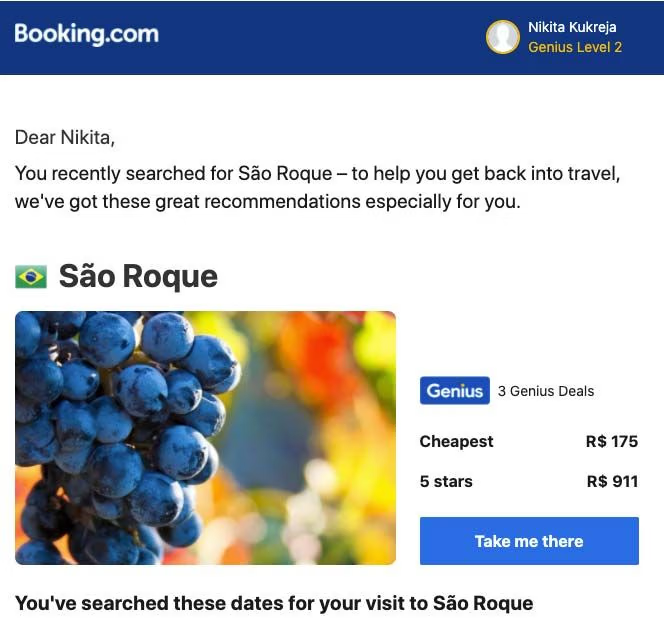7 Easy Ways to Segment Your Email List for Improved Engagement
Updated August 23, 2021
7 min read

When an email marketing campaign is well thought-out, it gives you the opportunity to increase engagement and have a fruitful relationship with your customers. But if you are crafting a great email and your email list is not segmented properly, it is time to assess what may be wrong.
 The first step is to understand that sending a larger volume of emails does not mean you’re likely to have a more successful campaign - and that is where segmenting your email list becomes necessary.
The first step is to understand that sending a larger volume of emails does not mean you’re likely to have a more successful campaign - and that is where segmenting your email list becomes necessary.Being relevant to your subscribers is critical in your marketing efforts, as not many people will react to content that is not tailored to their needs and preferences. Having a specific set of audience in mind when you create your campaign, will get you far more satisfying results, right away.
A Mailchimp study shows that segmented campaigns are opened 14% more, with CTRs increased by 65%, compared with non-segmented campaigns.
Segmentation allows you to increase engagement, consequently improving brand awareness, and generating more clicks and purchases.
What’s more, all segmentation processes are automated, meaning they don’t require constant manual settings. Configure segments once, and the system would add contacts automatically based on the events you select.
Having said that, figuring out the best way to segment your email marketing lists can be a challenge.
To make it a little less daunting, this post will show you 7 quick and easy segmentation strategies that you can get started on today!
How to start when segmenting your email list?
Begin with analyzing your consumers’ behavior data and categorize them into groups: this will help you segment them appropriately, and allow you to increase engagement and eventually - the ROI of your email marketing campaigns.
That is because when you cluster your potential customers, you can create better and more optimized campaigns, by having a personalized dialogue with the niche you want to reach.
However, there are a few basics that you will need in order to segment your list properly and effectively:
1. Email Segmentation Software
There are plenty of email software out there, so you can choose which one fits your goals best. But we will mention a few here:
- AWeber
- Constant Contact
- Active Campaign
Pro Tip: Before sending your next email campaign, make sure to clean your lists. Emailable has a native integration with Active Campaign, Constant Contact and 80+ more tools to make your life so much easier.
2. Lead Magnets
You’ll need to create some lead magnets that will allow your website visitors to self-identify as belonging to one of your segments.
A lead magnet is a free resource that attracts potential customers for your niche to click on. By using this free content, your audience is more likely to sign up for your email list and eventually become paying customers.
But you might be thinking: how can you cluster your email list? Which targets to apply? Keep reading!
7 easy ways to segment your email list
The definition of what data should be analyzed to make a cluster is not a secret. Some segmentation techniques are relevant for B2B companies, while others are more suitable for B2C. Likewise, some clusters apply to services companies, but would not make sense to those that sell physical products.
Therefore, to define which filters to use when segmenting your email list, it is necessary to analyze the data and deduce which ones make the most sense for your business. Among the most used segmentation strategies, we have:
1. Demographics
Many marketers use this simple way to segment – based on demographics such as age group, gender, income level, company position, etc.
This information can be really useful for you as it can tell you a lot about a person’s needs and preferences.
For example - segmenting by birthday is a nice thing to do for your subscribers, and it makes them feel special. By sending them targeted emails with special offers, or even just a simple “happy birthday” note, you can connect with them on a more personal level.
The more information you can get on a user, the easier it will be to segment based on demographic data. However, don’t bombard your users with irrelevant questions (you don’t need to know if and who they’re dating), as this might scare people off from signing up.
 Decide what is important for your business and choose the questions accordingly. For example, if you’re a B2B service provider, it might be important for you to know the user’s company position.
Decide what is important for your business and choose the questions accordingly. For example, if you’re a B2B service provider, it might be important for you to know the user’s company position.2. Geographic location
There are a lot of different ways to use geographic location data, making segmentation by geographic area a valuable tool – especially for companies where location greatly influences purchase behavior.
Similarly, if you’re creating a campaign focused on a specific area, then geolocation needs to be a focus for you when segmenting your email list, be it by country, state, city, or region.
For example, Litmus used geolocation to send targeted emails about their conference, which got them a 68% open rate compared to the 22% open rate for the general email that was sent out.
3. Email Engagement
This is another easy way to segment your email list, that can have a big impact on your overall results.
You can separate active and inactive users, by keeping track of open and click-through rates. For example, an inactive user can be defined as someone who hasn’t opened your emails in three months.
You can then create an email campaign to re-engage these inactive subscribers. Similarly, those who engage often with you can be rewarded by emails with special offers and secret gifts.
Sometimes there is a change in engagement and you need to be careful of these too. People simply get busy and they stop engaging with your emails like they used to. This can happen no matter what you do. However, if you don’t do anything to re-engage those subscribers, you could lose them forever.
4. Past purchases
Without a doubt, this is another easy but important segmentation strategy. Within it, it is possible to adapt the variables, such as frequency, events within the platform etc.
If you purchase a product, you must’ve received a suggestion for another one that possibly complements the first item. This is possible when companies segment their email lists based on past purchases.
Similarly, if it’s a product such as shampoo, you can send out an email campaign after a few months (when it would likely be over), to reorder that same one.
This strategy is likely to increase not only customer engagement, but also customer loyalty. Read this post to know more about developing loyalty through email campaigns.
5. Amount spent
The average ticket is directly linked to the adequacy of your email campaigns. That is because, by mining this consumption behavior data, you can scale the best offer for this consumer base.
If you sell a range of high-dollar and low-dollar items, this can be an important way of segmenting your email list.
Use purchase history to predict which customers are likely to spend on the more expensive items and which ones on the affordable ones. You can then send them email campaigns with offers that are relevant to them and are actually in their price range.
6. Position in the sales funnel
Segmenting your list based on the position in the sales funnel is an extremely valuable strategy.
Someone who has just joined your email list should definitely be receiving different content from someone who has been interested in what you have to offer for years.
For example, someone who is new should be receiving generic emails such as welcome emails to introduce them to your brand and a glimpse of all your offerings.
On the other hand, a user who has shown interest in a specific product and who is further along the funnel, should be seeing specific and targeted offers (and/or content).
Cart abandonment is a common indicator that someone’s at the bottom of the funnel. In March 2020 (according to Statista), 88% of all shopping orders were abandoned!
This is an opportunity for you – you can send a follow-up email reminding them that their cart is still available or a message featuring the products they were about to purchase. Look at the example from Booking.com below:
 Who amongst us hasn’t looked for tickets/hotels during the pandemic and then not been able to go through with the plan?
Who amongst us hasn’t looked for tickets/hotels during the pandemic and then not been able to go through with the plan?So, in conclusion: new subscribers need to be nurtured. Warm leads need to be primed for the sale and eventually sold. Customers need to be presented with cross-sells or upsells. Every stage should have its own unique email marketing campaign.
7. Segmenting by email quality
Although these segmentation strategies are functional for conversions, panning the data is not limited to these clusters. You need to take a step back to ensure the deliverability of your campaign and avoid damaging your sender reputation: enter email verification.
By using Emailable, you guarantee that your email list consists only of valid addresses, avoiding bouncebacks. It is simple - you need to import the email list, with or without integration, to maintain optimum email list quality.
You will then receive the email verification results, and each email will be classified as either deliverable, risky, undeliverable, or unknown.
We recommend you only send to the deliverable emails, but if you were confident sending to some of the emails we mark as “risky”, you must take caution and keep them in a separate list.
Depending on campaign results, you can then take more definitive action.
Wrapping up
There are many ways you can segment your email lists, and you know about 6 easy ones that you can implement today.
Remember that which strategy, or combination of strategies will depend on the type of business you are and what you are trying to achieve.
Email verification plays a key role, and you can try Emailable for free as you get 250 free credits when you sign up. Please get in touch if you have any questions or comments.